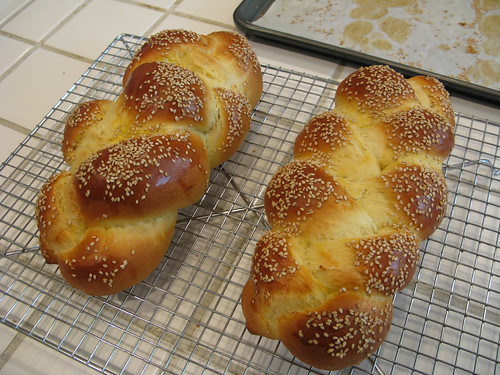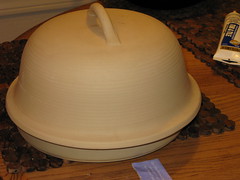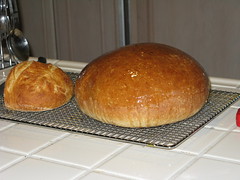Although still a bit behind others in the BBA Challenge, I’m beginning to catch up to the front-runners (not that it’s a race but it’s fun to be baking the same thing with a group of people). Ciabatta legend has portrayed it as a notoriously difficult bread. Achieving the proper holes critical to deeming it truly ciabatta. And, I don’t know about you, but everytime I hear the word ‘ciabatta’ – even in my head – I hear it as ‘chi-BAH-ta chi-BAT-ta chi-BAT-ta’ – like a little dance tune – like Robin Williams saying, “maDONna maDONna maDONna” in ‘The Birdcage‘. Probably just personal demons.
I approached the baking of the ciabatta with due caution and respect. And a litle fear. Who wants to end up with failed ciabatta (chiBAHta chiBAHta chiBAHta…sorry, I’ll try to stop)? Many of the BBA challengers have posted wonderful pictures of their successful exploits. Beautiful holes, golden crust, some have even been stuffed with the likes of caramelized onions and mushrooms (my stomach just grumbled at the mere thought of such delectables). Now the moment had come.
I carefully read the instructions in The Bread Baker’s Apprentice several times. Reviewed the pictures of the ‘stretch-and-fold’ maneuver. Made sure my couche cloth was near at hand. I was ready.
I had decided to do this bread entirely by hand (rather than using my mixer and dough hook). In fact, I’ve been thinking of doing all breads this way from now on. I think some of my previous difficulties like The Great Bagel Disaster and Casatiello may have their roots in relying too much on the mixer. I have found that mixing by hand I have a much better feel for the dough (pun intended – sorry). It’s also a slightly slower process so it’s easier to keep the dough in control. With the mixer, there’s a tendency (on my part, at least) to feel I have to add more flour in order to get the dough to clear the sides. But, often, I end up adding to much flour and resulting in a very stiff dough. And once it’s stiffened up like that it’s next to impossible to re-hydrate it enough to become a lovely, pliable mass of dough.
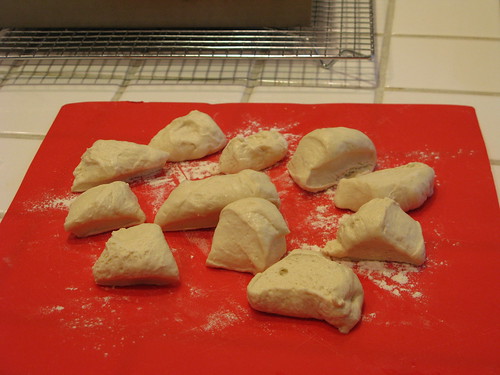
Biga - cut up and warming to room temp
The biga had been made the afternoon before and had about 15-16 hours of fermentation in the frig. It looked quite puffed up when I took it out and cut it up into smallish pieces and it felt nice and soft. I was a little concerned about doing the biga version (rather than the poolish one). It seemed like adding lumps of dough to create a very wet dough would just result in lumpy dough (I speak, unfortunately, from experience). But, from reading others experiences, it seemed that the biga was working out better hole-wise.
While the biga rested I decided to bake some Challah to take to our very good friend’s house that day. Ellen loves Challah. I had made the BBA Challah and it was pretty good but I found it a little drier than I like so I hunted around for another recipe and found this one. It’s not that different from the BBA one but uses slightly less water, slightly more honey and egg. And it’s fun to experiment. I also did this one by hand. 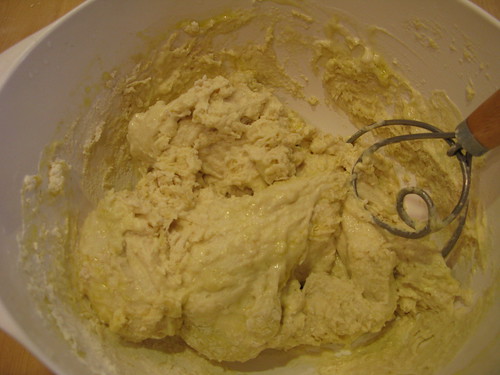 I mixed the dough up in a bowl using my dough whisk. If you don’t have one of these babies, get one. It makes mixing up even fairly heavy doughs by hand a snap and cleans up easily. It’s great for lighter batters and such as well. The dough quickly came together, turned out on my board, kneaded it for 5 minutes or so and it was ready for it’s first rise.
I mixed the dough up in a bowl using my dough whisk. If you don’t have one of these babies, get one. It makes mixing up even fairly heavy doughs by hand a snap and cleans up easily. It’s great for lighter batters and such as well. The dough quickly came together, turned out on my board, kneaded it for 5 minutes or so and it was ready for it’s first rise.
Then it was time to walk the dog and do a quick errand. By the time I was back the biga was warmed enough to get going on the ciabatta (chiBAHta chiBAH…sorry, sorry). I placed all the ingredients in a bowl adding the cut up biga. Using my dough whisk, I quickly had a shaggy mass of dough.  According to instructions, I had a bowl of water nearby. Dipping my hand in the water first, I used my claw, er, hand to knead the dough kind of like a dough hook would while turning the bowl. I kept dipping and kneading until I had a nice, uniform and VERY wet dough. It was kind of fun doing the whole wet hand mixing thing. Like making mud pies. Only slimier.
According to instructions, I had a bowl of water nearby. Dipping my hand in the water first, I used my claw, er, hand to knead the dough kind of like a dough hook would while turning the bowl. I kept dipping and kneading until I had a nice, uniform and VERY wet dough. It was kind of fun doing the whole wet hand mixing thing. Like making mud pies. Only slimier.
Once it was feeling good (pliable, smooth and, most importantly, wet), I made a little bed of flour on my board, dumped it out and formed a rectangle.  Now was the time for the first stretch-and-fold. I was a little trepidatious but it was really easy. The dough was very compliant. I floured it and me well, carefully loosened it with a bench scraper and lifted each end. Lo and behold…streeeeetch! The folding part was a piece of cake…or bread. Set it to resting and proceeded to shower and dress. Once properly put together for the day (or as good as it gets for me), the ciabatta was ready for it’s next exercise period: streeetch-and-fold. Back to resting.
Now was the time for the first stretch-and-fold. I was a little trepidatious but it was really easy. The dough was very compliant. I floured it and me well, carefully loosened it with a bench scraper and lifted each end. Lo and behold…streeeeetch! The folding part was a piece of cake…or bread. Set it to resting and proceeded to shower and dress. Once properly put together for the day (or as good as it gets for me), the ciabatta was ready for it’s next exercise period: streeetch-and-fold. Back to resting.
After another 30 minutes or so, the ciabatta had risen A LOT. It was a little scary how big the lump had gotten. I figured this was signal to go ahead and shape it. I had prepared the couche with lots of flour. I cut the heap’o’dough into 3 pieces and easily shaped them into rectangles, placed them on the couche and rucked it up between them to form a nice, comfy coach…er..couche. I puttered around a bit, tweeted, checked email.

The challah had swelled fairly nicely by now (it had been about 2 hours). It didn’t really look doubled to me which was surprising as it was nicely warm in the kitchen but that’s how it goes sometimes. I made an executive decision that it was ready for shaping. And shape it I did. I decided on two loaves as I wanted one for Ellen and the other to take to my mother. She, my mother, had complained that I hadn’t brought her any of the other challah so I hoped this would make her happy (or as happy as my mother gets). After wrestling with the braiding, I got them nicely shaped.  I don’t know why the braiding is so hard…I have no trouble braiding hair. (I actually think I may have figured it out during a dream…so we’ll see next time. And why I’m dreaming about making bread rather than hunky men I don’t know but it’s very disappointing.)
I don’t know why the braiding is so hard…I have no trouble braiding hair. (I actually think I may have figured it out during a dream…so we’ll see next time. And why I’m dreaming about making bread rather than hunky men I don’t know but it’s very disappointing.)
My husband returned from his workout and proclaimed his imminent starvation. Since I wanted to bake the ciabatta before going anywhere I got him to put his tummy on hold for an hour. I figured I could refrigerate the challah braids and bake them when we came back but I didn’t want to the ciabatta to wait and it bakes really quickly. I decided, since I had three pieces, to experiement a bit. So I heated up my stone in the upper oven and my La Cloche in the lower oven. If you haven’t seen the La Cloche you should check it out. It’s a great substitute for an oven hearth. I was really curious to compare and contrast.
Once the ovens were heated, I floured my Super Peel (another REALLY handy item) with semolina and transfered two of the loaves to it. Again, it was quite easy although the dough is quite soft. Just a bit of help with the bench scraper and they were on the peel.  From there it was easy to transfer them to the hot stone in the upper oven, dump a cup of water and close the door. The third loaf was transferred to the re-dusted peel and this one was placed in the La Cloche. It was a tiny bit long for the round base but it smooshed itself into a slight curve which was fine with me. I replaced the cover and closed the door. Spritzed the upper oven a couple of times. And let them all all bake.
From there it was easy to transfer them to the hot stone in the upper oven, dump a cup of water and close the door. The third loaf was transferred to the re-dusted peel and this one was placed in the La Cloche. It was a tiny bit long for the round base but it smooshed itself into a slight curve which was fine with me. I replaced the cover and closed the door. Spritzed the upper oven a couple of times. And let them all all bake.


In just 15 minutes all three had reached the requisite 205 degrees and were ready! It was quite interesting to see the difference in color between the two. The ones done in the oven on the stone were pale golden colored. The one in the La Cloche as a much richer gold. I left them to cool (even though hardly able to wait to see the inside), stuck the braids of challah in the frig and we were off to lunch and errands.

The La Cloche baked one is on the right
Returning home the moment of truth arrived. I sliced one of the stone made breads and it looked good but, alas, no big holes. The texture was quite nice and the taste was good although a little bland. Then I tried the one made in the La Cloche and, I think, there was a significant difference. The texture was MUCH more open. No huge holes, but lots of medium size ones. The taste was similar to the others but the texture was lighter, less chewey. All-in-all I’m calling them all a success. I really enjoyed making them. Working with the wet dough was a lot of fun and actually quite easy. And I’m eating ciabatta dipped in a little olive oil as I write.

Stone Baked Ciabatta

La Cloche Baked Ciabatta
And the challah? They had huge oven spring. They looked beautiful coming out of the oven. We left shortly after for Peter and Ellen’s (to spend 4th of July lolling at their pool) and Ellen’s challah was still warm when we got there. She received it delightedly and tore into immediately. I must say that once I got a look at it (after prying her fingers off the loaf and making her stop shouting, “mine, mine”) that it was a significantly fluffier texture than the BBA challah. The taste was excellent, a little more egg-y and sweeter. Now I may have to try others or experiment with these because leaving well enough alone is just no fun at all.
